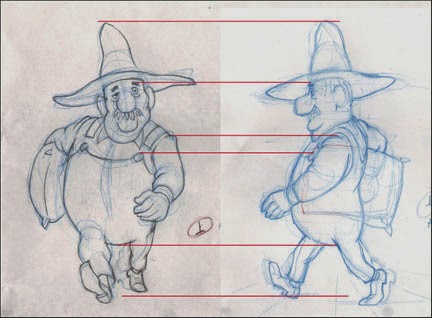Solution to "Mystery Change"
In the last post (No. 61), I challenged you to find a difference in timing between the two versions of the walk cycle. No one took me up on it, and I admit it was a subtle detail to find amid everything else that was going on in the cycle. But the answer is: I changed the timing of the right arm (the one holding the bag). In version 1, as the bag comes forward and then reverses direction to recede again, the movement seemed to me to have a stabbing aspect to it; that is, it took no time and no effort to reverse direction. I thought this was inappropriate for a bag that might weigh 100 pounds or 45 kilograms.
I therefore took a look at the spacing of the drawings. As the bag comes forward, it has an appropriate cushion-in. The chart below shows the relative positions of the seam at the front of the bag.
But as the bag reverses direction, the drawings were not spaced so as to give a good impression of the cushion-out (the spacing that indicates that an object starts out slowly and accelerates.) The next chart shows both the old and the improved spacings. Again, it is the seam on the bag that we are following.
 |
| The original spacing is shown in red, on the left. Final spacing on the right. |
Translating to the Side View
The obvious way to begin this translation of view is to construct the first image over the corresponding one of the other. On my drawing board, that looks like this: |
| The front view showing through on my backlighted animation disk. |
Here are the two images separated, with a few points of congruence highlighted:
 |
| Showing where the top of the hat, the eyebrow, the shoulder seam, the top of the button and the bottom of the body mass coincide in both drawings. |
It should be emphasized that a walk cycle--or any animation, for that matter--should be designed with the perspective of its layout or background in mind; note the converging lines like floorboards on the drawing at right above, indicating the plane upon which the character is walking. If you animate something without regard for the perspective and scale of the layout, you may be wasting time and work. This should be considered even if creating something such as a gif animation meant to occupy the featureless expanse of a webpage.
Creating other angles wherein the viewpoint is raised or lowered is also possible, but here more sophisticated drawing skills are required to extrapolate from one to the other.
 | |
| The same pose from a high angle, 3/4-front view. |
Here is the first pencil test of the side view walk cycle:
So I shortened his stride by this much:
 |
| The erased images in red brackets show the original reach of his stride. |
I like this second version; except for details and cleanup, I am calling it done.
Your comments and questions are always welcome, and if you like what I am doing here, why not click on the Join This Site button and become a Follower? That way you won't miss any posts, and I promise you many more to come!
Coming soon: Walks for Albert's Companions, a Fox and a Goose--two short-legged characters who must keep up with Albert's rapid pace!


No comments:
Post a Comment